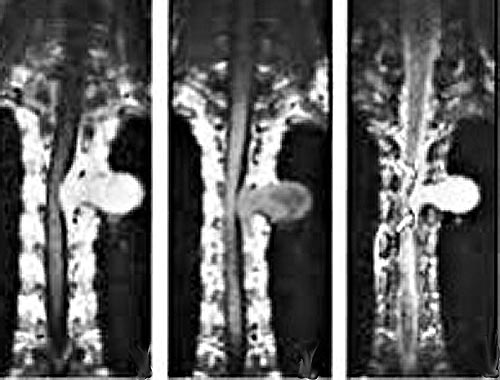Ganglioneuroma

Published: 18 Jun 2025
ICD9: 215.5 ICD10: D21.4 ICD11: XH03L9
A ganglioneuroma is a rare, benign (non-cancerous) tumor that arises from nerve tissue.
Specifically, it originates from sympathetic nerve cells (ganglion cells) and their supporting cells (Schwann cells) of the autonomic nervous system.
Here's a breakdown of what that means:
![]() Sympathetic Nervous System: Part of the autonomic nervous system, which controls involuntary functions like heart rate, blood pressure, digestion, and sweating. It's responsible for the "fight or flight" response.
Sympathetic Nervous System: Part of the autonomic nervous system, which controls involuntary functions like heart rate, blood pressure, digestion, and sweating. It's responsible for the "fight or flight" response.
![]() Ganglion Cells: These are nerve cells located in clusters called ganglia. Ganglia are like relay stations for nerve signals.
Ganglion Cells: These are nerve cells located in clusters called ganglia. Ganglia are like relay stations for nerve signals.
![]() Schwann Cells: Supporting cells that surround and insulate nerve fibers, helping them transmit signals quickly and efficiently.
Schwann Cells: Supporting cells that surround and insulate nerve fibers, helping them transmit signals quickly and efficiently.
![]() Benign: Means the tumor is not cancerous and doesn't spread to other parts of the body. It grows locally.
Benign: Means the tumor is not cancerous and doesn't spread to other parts of the body. It grows locally.
Where do they occur?
Ganglioneuromas most commonly occur in the abdomen (especially the adrenal gland and retroperitoneum) and the chest (mediastinum). They can also occur in the neck and rarely in other locations.
Who gets them?
Ganglioneuromas can occur at any age, but they are most frequently diagnosed in children and young adults.
Symptoms:
Many ganglioneuromas are asymptomatic, meaning they don't cause any noticeable symptoms and are discovered incidentally during imaging tests for other reasons.
When symptoms do occur, they depend on the tumor's size and location and may include:
![]() Abdominal pain or mass
Abdominal pain or mass
![]() Chest pain or pressure
Chest pain or pressure
![]() Changes in bowel or bladder habits
Changes in bowel or bladder habits
![]() Hormone-related effects: Some ganglioneuromas can produce hormones (like catecholamines), leading to symptoms like high blood pressure, sweating, flushing, and anxiety.
Hormone-related effects: Some ganglioneuromas can produce hormones (like catecholamines), leading to symptoms like high blood pressure, sweating, flushing, and anxiety.
![]() Spinal cord compression: If located near the spine, the tumor can compress the spinal cord, causing weakness, numbness, or pain in the limbs.
Spinal cord compression: If located near the spine, the tumor can compress the spinal cord, causing weakness, numbness, or pain in the limbs.
Diagnosis:
Diagnosis usually involves:
![]() Imaging studies: CT scans, MRI, and ultrasound are used to visualize the tumor and assess its size and location.
Imaging studies: CT scans, MRI, and ultrasound are used to visualize the tumor and assess its size and location.
![]() Urine and blood tests: To check for elevated levels of hormones like catecholamines (epinephrine and norepinephrine).
Urine and blood tests: To check for elevated levels of hormones like catecholamines (epinephrine and norepinephrine).
![]() Biopsy: A sample of the tumor is taken for microscopic examination to confirm the diagnosis and rule out other types of tumors. Imaging characteristics are often quite specific, and biopsy is not always required.
Biopsy: A sample of the tumor is taken for microscopic examination to confirm the diagnosis and rule out other types of tumors. Imaging characteristics are often quite specific, and biopsy is not always required.
Treatment:
The primary treatment for ganglioneuroma is surgical removal of the tumor. Because these are benign tumors, complete surgical resection is often curative.
![]() Observation: In some cases, if the tumor is small, asymptomatic, and not growing, doctors may choose to monitor it with regular imaging studies instead of immediate surgery.
Observation: In some cases, if the tumor is small, asymptomatic, and not growing, doctors may choose to monitor it with regular imaging studies instead of immediate surgery.
![]() Other Treatments: In very rare cases where surgery is not possible or the tumor recurs, other treatments such as radiation therapy or chemotherapy might be considered, but these are not typically used for ganglioneuromas.
Other Treatments: In very rare cases where surgery is not possible or the tumor recurs, other treatments such as radiation therapy or chemotherapy might be considered, but these are not typically used for ganglioneuromas.
Prognosis:
The prognosis for ganglioneuroma is excellent after complete surgical removal. Recurrence is rare. Because the tumor is benign, it does not spread to other parts of the body.
Key Takeaways:
![]() Ganglioneuromas are benign tumors of the sympathetic nervous system.
Ganglioneuromas are benign tumors of the sympathetic nervous system.
![]() They are often asymptomatic.
They are often asymptomatic.
![]() Surgery is the primary treatment and is usually curative.
Surgery is the primary treatment and is usually curative.
![]() The prognosis is excellent.
The prognosis is excellent.
If you suspect you or someone you know might have a ganglioneuroma, it's crucial to consult with a doctor for proper diagnosis and treatment. A pediatric surgeon or a surgical oncologist would typically be the specialists involved in the care of this tumor.